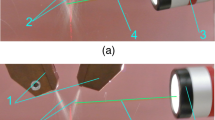Abstract
The utilization of powders is the main factor determining the cost of laser-cladding industrial applications. The work established a 3D numerical model of gas-powder two-phase flow in the coaxial powder-feeding process to understand the gas-powder flow stream characteristics and improve the utilization of powders and the forming efficiency. The verified model was used to analyze the influences of the distance between the nozzle and substrate, carrier-gas flow rate, and powder feeding voltage on powders’ concentration on the substrate, cladding morphology, and powders’ utilization efficiency. The results showed that 9.5 mm was the optimal working distance of the nozzle, with the highest powder concentration on the substrate and the highest powder utilization rate. Appropriately increasing the gas flow rate was conducive to gathering powder particles; however, the increased gas flow rate aggravated particles to spray outwards and reduced the powder concentration on the substrate. After powder-feeding gas flow rate GF = 8 NL/min, the focused powder diameter no longer decreased. At this time, the cladding area was the maximum with the highest utilization rate of powders. As the powder feeding voltage increased, the cladding area and the utilization rate of powders increased. This model can accurately predict the transportation and concentration of powders on the substrate, which provides theoretical guidance for efficient forming by laser cladding.

















Similar content being viewed by others
References
Lian G, Zhang H, Zhang Y, Tanaka M, Chen C, Jiang J (2019) Optimizing processing parameters for multi-track laser cladding utilizing multi-response grey relational analysis. Coatings 9(6):356. https://doi.org/10.3390/coatings9060356
Lian G, Liu Z, Zhang Y, Feng M, Chen C, Jiang J (2020) The forming control method of multi-track laser cladding on curved surface. Metals 10(8):1109. https://doi.org/10.3390/met10081109
Lian G, Zhang H, Zhang Y, Yao M, Huang X, Chen C (2019) Computational and experimental investigation of micro-hardness and wear resistance of Ni-based alloy and TiC composite coating obtained by laser cladding. Materials 12(5):793. https://doi.org/10.3390/ma12050793
Ju H, Zhang Z, Lin C, Liu Z, Jiang H (2019) Design optimization and experimental study of coaxial powder-feeding nozzle in the laser cladding process. IOP Conf Ser: Mater Sci Eng 74(1):0.12008
Jang S, Zheng B, Schoenung J (2022) Directed energy deposition of metal matrix composites: computational and experimental comparison of powder particle flow behavior. J Market Res 16:516–529. https://doi.org/10.1016/J.JMRT.2021.12.009
Tan H, Zhang C, Fan W, Zhang F, Lin X, Chen J, Huang W (2020) Dynamic evolution of powder stream convergence with powder feeding durations in direct energy deposition. Int J Mach Tool Manu 157:103606. https://doi.org/10.1016/j.ijmachtools.2020.103606
Tan H, Fang Y, Zhong C, Yuan Z, Fan W, Li Z, Chen J, Lin X (2020) Investigation of heating behavior of laser beam on powder stream in directed energy deposition. Surf Coat Tech 397:126061. https://doi.org/10.1016/j.surfcoat.2020.126061
Doubenskaia M, Kulish A, Sova A, Petrovskiy P, Smurov I (2021) Experimental and numerical study of gas-powder flux in coaxial laser cladding nozzles of Precitec. Surf Coat Tech 406:126672. https://doi.org/10.1016/j.surfcoat.2020.126672
Xia Y, Huang Z, Chen H, Liang X, Lei J (2021) Numerical simulation and experimental investigation on powder transport of a new-type annular coaxial nozzle. Int J Adv Manuf Tech 115(7):2353–2364
Gong X, Wang J, Feng H (2019) Lateral powder transport model with Gaussian distribution in laser cladding. Int J Adv Manuf Tech 102(9):3747–3756
Li C, Zhang D, Yang Y, Gao H, Han X (2021) Research on sputtering behavior of three beams coaxial laser cladding powder based on the interaction of lasers and powder. J Laser Appl 33(4):042020. https://doi.org/10.2351/7.0000449
Zhang J, Yang L, Zhang W, Qiu J, Xiao H, Liu Y (2020) Numerical simulation and experimental study for aerodynamic characteristics and powder transport behavior of novel nozzle. Opt Laser Eng 126:105873. https://doi.org/10.1016/j.optlaseng.2019.105873
Li L, Huang Y, Zou C, Tao W (2021) Numerical study on powder stream characteristics of coaxial laser metal deposition nozzle. Crystals 11(3). https://doi.org/10.3390/CRYST11030282
Su P, Li H, Yang J, Huang D (2021) Optimal design of structure parameters of coaxial powder feeding nozzle for laser cladding. J Phys: Conf Series 1978:(1). https://doi.org/10.1088/1742-6596/1798/1/012050
Khairallah S, Anderson A, Rubenchik A, King W (2020) Corrigendum to “laser powder-bed fusion additive manufacturing: physics of complex melt flow and formation mechanisms of pores, spatter, and denudation zones”[Acta Mater. 108, 2016 36–45]. Acta Mater 196:30
Wang Z (2020) Research on the utilization and recycling of laser melting deposited powder. Dalian University of Technology
Liu H, Hao J, Yu G, Yang H, Wang L, Han Z (2016) A numerical study on metallic powder flow in coaxial laser cladding. J Appl Fluid Mech 9(5):2247–2256
Liu H, He X, Yu G, Wang Z, Li S, Zheng C, Ning W (2015) Numerical simulation of powder transport behavior in laser cladding with coaxial powder feeding. Sci China Phys Mech 58(10):1–10
Funding
The work was supported by the Program for Innovative Research Team in Science and Technology in Fujian Province University.
Author information
Authors and Affiliations
Contributions
All authors contributed to the work’s conception and design. Material preparation, data collection, and analysis were performed by Mengya Chu, Guofu Lian, Mingpu Yao, Meiyan Feng, Changrong Chen, and Xu Huang. The first draft of the manuscript was written by Mengya Chu, and all authors commented on previous versions of the manuscript. All authors read and approved the final manuscript.
Corresponding authors
Ethics declarations
Competing interests
The authors declare no competing interests.
Additional information
Publisher's Note
Springer Nature remains neutral with regard to jurisdictional claims in published maps and institutional affiliations.
Rights and permissions
Springer Nature or its licensor holds exclusive rights to this article under a publishing agreement with the author(s) or other rightsholder(s); author self-archiving of the accepted manuscript version of this article is solely governed by the terms of such publishing agreement and applicable law.
About this article
Cite this article
Chu, M., Lian, G., Yao, M. et al. Numerical simulation and experimental investigation of gas-powder flow feed behavior in laser cladding with coaxial nozzle. Int J Adv Manuf Technol 122, 881–894 (2022). https://doi.org/10.1007/s00170-022-09768-y
Received:
Accepted:
Published:
Issue Date:
DOI: https://doi.org/10.1007/s00170-022-09768-y




